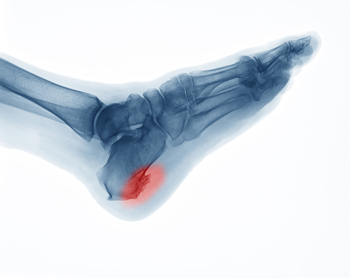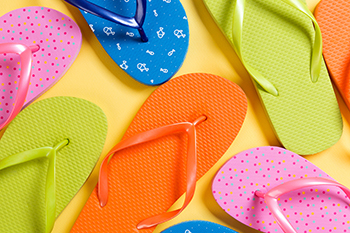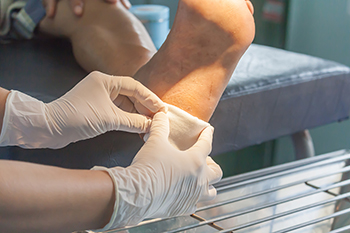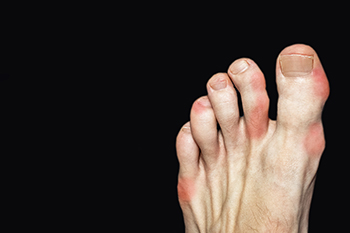Items filtered by date: July 2022
What You Might Feel With Heel Spurs

Heel spurs can affect a variety of different individuals. The condition is characterized by the formation of a bony outgrowth made up of calcium deposits. This outgrowth begins at the heel and then grows toward the arch of the foot or the plantar fascia. It can be very helpful to learn about some of the common symptoms of heel spurs in case you ever develop this condition. It is important to note, however, that every patient is different and experiences different symptoms. For example, some patients with heel spurs experience no symptoms. These patients will only discover that they have heel spurs after undergoing an X-ray. Other patients can experience great pain with heel spurs. Specifically, some people may experience a sharp, shooting pain in the heel area at the beginning of the day when first putting weight on their feet. A muddled pain in the heel can also be felt throughout the day. Some people with heel spurs might even experience a kind of heat coming from the affected heel in some cases. If you have heel spurs, you might experience some kind of inflammation and swelling as well. Symptoms of heel spurs are highly specific to each patient, so reach out to a podiatrist who can help with your specific case.
Heel spurs can be incredibly painful and sometimes may make you unable to participate in physical activities. To get medical care for your heel spurs, contact Jim Maxka, DPM from South Penn Foot & Ankle Associates. Our doctor will do everything possible to treat your condition.
Heels Spurs
Heel spurs are formed by calcium deposits on the back of the foot where the heel is. This can also be caused by small fragments of bone breaking off one section of the foot, attaching onto the back of the foot. Heel spurs can also be bone growth on the back of the foot and may grow in the direction of the arch of the foot.
Older individuals usually suffer from heel spurs and pain sometimes intensifies with age. One of the main condition's spurs are related to is plantar fasciitis.
Pain
The pain associated with spurs is often because of weight placed on the feet. When someone is walking, their entire weight is concentrated on the feet. Bone spurs then have the tendency to affect other bones and tissues around the foot. As the pain continues, the feet will become tender and sensitive over time.
Treatments
There are many ways to treat heel spurs. If one is suffering from heel spurs in conjunction with pain, there are several methods for healing. Medication, surgery, and herbal care are some options.
If you have any questions feel free to contact our office located in Hanover, PA . We offer the latest in diagnostic and treatment technology to meet your needs.
Flip Flops May Cause Foot Pain

The simplicity of wearing flip flops is attractive to many people. They are available in many colors and styles, and are easy to slip on in a hurry. Despite their popularity, research has indicated they may cause foot problems. People commonly notice heel pain, and this can be a result of an absence of an arch in the shoe. Additionally, a pain in the big toe may be indicative of a bunion forming, and the toes may ache from constantly trying to keep the flip flop on the foot. A reason the foot muscles work harder when flip flops are worn may have to do with being an open back shoe. Most flip flops do not have a strap on the back, and the gait, or walking style, can be negatively affected. It is beneficial to perform exercises and stretches that can strengthen the foot and calf muscles, which may make it more comfortable to walk. If you would like additional information about what type of flip flops to wear that are good for the feet, please confer with a podiatrist.
Flip-flops can cause a lot of problems for your feet. If you have any concerns about your feet or ankles, contact Jim Maxka, DPM from South Penn Foot & Ankle Associates. Our doctor will assist you with all of your foot and ankle needs.
Flip-Flops and Feet
Flip-flops have managed to become a summer essential for a lot of people. While the shoes may be stylish and easy to slip on and off, they can be dangerous to those who wear them too often. These shoes might protect you from fungal infections such as athlete’s foot, but they can also give you foot pain and sprained ankles if you trip while wearing them.
When Are They Okay to Wear?
Flip-flops should only be worn for very short periods of time. They can help protect your feet in places that are crawling with fungi, such as gym locker rooms. Athlete’s foot and plantar warts are two common fungi that flip-flops may help protect your feet against.
Why Are They Bad for My Feet?
These shoes do not offer any arch support, so they are not ideal for everyday use. They also do not provide shock absorption or heel cushioning which can be problematic for your feet. Additionally, you may suffer from glass cuts, puncture wounds, and stubbed toes since they offer little protection for your feet.
More Reasons Why They Are Bad for Your Feet
- They Slow You Down
- May Cause Blisters and Calluses
- Expose Your Feet to Bacteria
If you have any questions, please feel free to contact our office located in Hanover, PA . We offer the newest diagnostic and treatment technologies for all your foot care needs.
Why Live with Pain and Numbness in Your Feet?
Types of Foot Ulcers

Patients who are diabetic may be familiar with wound care for the feet. Elevated blood sugar levels may cause a foot ulcer to gradually develop and immediate treatment may be necessary to avoid further implications, including amputation in severe cases. There are several types of foot ulcers that diabetic patients may experience. Neuropathy can cause a lack of feeling in the foot and patients are unable to feel the pain caused by an injury. A loss of blood flow to the feet can lead to an ischemic ulcer which can be difficult to treat. If the patient has poor circulation and neuropathy, a neuroischemic ulcer may form and it is said to be the most difficult to heal. Approximately half of foot ulcers become infected, therefore they need to be closely monitored. Diabetic foot ulcer treatment begins with removing infected tissue from the wound. This is called debridement and it is crucial in the prevention of damaged nerves, blood vessels, and tendons. This is followed by reducing existing pressure on the foot ulcer and draining the wound. If you have diabetes, it is strongly advised that you are under the care of a podiatrist who can treat and manage diabetic foot problems.
Wound care is an important part in dealing with diabetes. If you have diabetes and a foot wound or would like more information about wound care for diabetics, consult with Jim Maxka, DPM from South Penn Foot & Ankle Associates. Our doctor will assess your condition and provide you with quality foot and ankle treatment.
What Is Wound Care?
Wound care is the practice of taking proper care of a wound. This can range from the smallest to the largest of wounds. While everyone can benefit from proper wound care, it is much more important for diabetics. Diabetics often suffer from poor blood circulation which causes wounds to heal much slower than they would in a non-diabetic.
What Is the Importance of Wound Care?
While it may not seem apparent with small ulcers on the foot, for diabetics, any size ulcer can become infected. Diabetics often also suffer from neuropathy, or nerve loss. This means they might not even feel when they have an ulcer on their foot. If the wound becomes severely infected, amputation may be necessary. Therefore, it is of the upmost importance to properly care for any and all foot wounds.
How to Care for Wounds
The best way to care for foot wounds is to prevent them. For diabetics, this means daily inspections of the feet for any signs of abnormalities or ulcers. It is also recommended to see a podiatrist several times a year for a foot inspection. If you do have an ulcer, run the wound under water to clear dirt from the wound; then apply antibiotic ointment to the wound and cover with a bandage. Bandages should be changed daily and keeping pressure off the wound is smart. It is advised to see a podiatrist, who can keep an eye on it.
If you have any questions, please feel free to contact our office located in Hanover, PA . We offer the newest diagnostic and treatment technologies for all your foot care needs.
Foods That May Cause Gout

People who have pain in the joint of the big toe may have a condition known as gout. It is defined as an inflammation of the joints in the big toe and is considered to be a form of arthritis. It can produce debilitating pain and discomfort, and many patients find it difficult to walk. It can develop if there is a family history of gout or from eating foods that have high levels of purines. These types of foods include red meat, shellfish, and drinks that are made with large amounts of sugar. A gout attack can last a few days or several weeks and may improve gradually. The majority of people may have difficulty completing daily activities when gout is present and medical treatment may be needed. Effective prevention techniques can include reducing the amount of alcohol, red meat, and fatty foods in daily food intake. Additionally, it can help to drink plenty of fresh water frequently and begin a gentle exercise regime. If you are afflicted by gout, it is strongly advised that you are under the care of a podiatrist who can prescribe the appropriate medication for this condition.
Gout is a painful condition that can be treated. If you are seeking treatment, contact Jim Maxka, DPM from South Penn Foot & Ankle Associates. Our doctor will treat your foot and ankle needs.
What Is Gout?
Gout is a form of arthritis that is characterized by sudden, severe attacks of pain, redness, and tenderness in the joints. The condition usually affects the joint at the base of the big toe. A gout attack can occur at any random time, such as the middle of the night while you are asleep.
Symptoms
- Intense Joint Pain - Usually around the large joint of your big toe, and it most severe within the first four to twelve hours
- Lingering Discomfort - Joint discomfort may last from a few days to a few weeks
- Inflammation and Redness -Affected joints may become swollen, tender, warm and red
- Limited Range of Motion - May experience a decrease in joint mobility
Risk Factors
- Genetics - If family members have gout, you’re more likely to have it
- Medications - Diuretic medications can raise uric acid levels
- Gender/Age - Gout is more common in men until the age of 60. It is believed that estrogen protects women until that point
- Diet - Eating red meat and shellfish increases your risk
- Alcohol - Having more than two alcoholic drinks per day increases your risk
- Obesity - Obese people are at a higher risk for gout
Prior to visiting your podiatrist to receive treatment for gout, there are a few things you should do beforehand. If you have gout you should write down your symptoms--including when they started and how often you experience them, important medical information you may have, and any questions you may have. Writing down these three things will help your podiatrist in assessing your specific situation so that he or she may provide the best route of treatment for you.
If you have any questions, please feel free to contact our office located in Hanover, PA . We offer the newest diagnostic and treatment technologies for all your foot care needs.

